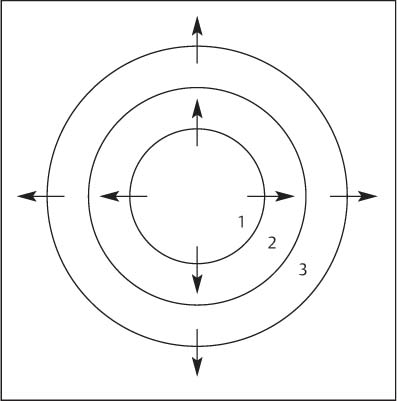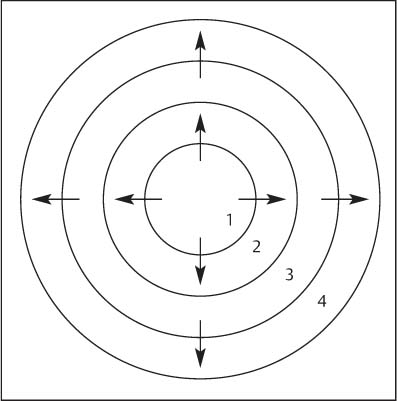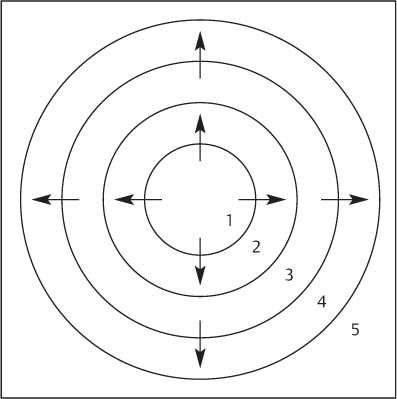17 Introduction to the Treatment of Specific Problems/Diseases In the previous chapters I have described how to handle treating children, the basic goals, and underlying methods for applying treatment to children and babies. We saw in particular that it is important to minimize or eliminate unnecessary emotional reactions to what we are doing, as these can interfere with treatment. It was proposed that we do as much as we can to help the child maintain emotional calmness. I have also described the tools, methods, and pattern for applying the core non-pattern-based root treatment and a simple form of pattern-based root treatment. In this final section I will examine various ideas and experiences using different tools and techniques to additionally target relief of symptoms. It is useful to briefly contextualize these different aspects of treatment in a model. To do this, I repeat the basic three-level model outlined in Chapter 9 (seen in Fig. 17.1). Level 1 represents the functional structural systems of the body (all organs—including locomotor organs). Level 2 represents the jing mai or channel system, which traditional theory tells us helps regulate the internal functional systems (represented by level 1). Level 3 represents the vitality of the child, their overall or global qi (e.g., yuan qi, zheng qi, sheng qi). This helps further regulate the channel and functional systems in the levels below it. Next I extend the model to include the further level, level 4, the mental (including emotional) level. This is seen in Fig. 17.2. If the mental level is regulated (calmed), it can help contribute toward an increased regulation of the levels below it (vitality, channels, and functional systems). The manner in which we handle the child and try to make sure that we cause no additional upset or fear, or cause distress to the child will affect level 4, helping trigger some degree of increased ordering of the levels below. The application of the core non-pattern-based root treatment primarily works on the vitality level, level 3, helping trigger increased regulation of the levels below it. The pattern-based root treatment primarily regulates the channels at level 2, helping regulate the level below it. The various symptomatic treatments help further change the functional structural, physical systems to relieve symptoms; that is, they work mostly at level 1. Thus, the whole treatment when put together can access and work at all four levels. Fig. 17.1 Three-level model: Level 1—functional systems (zang fu, etc.) Level 2—channel systems Level 3—vitality: global qi of the body Fig. 17.2 Four-level model: Level 1—functional systems (zang fu, etc.) Level 2—channel systems Level 3—vitality: global qi of the body Level 4—mind: heart/mind Fig. 17.3 Five-level model: Level 1—functional systems (e.g., zang fu) Level 2—channel systems Level 3—vitality: global qi of the body (e.g., zheng qi, sheng qi, yuan qi) Level 4—mind: heart/mind (e.g., yi: intention/attention/awareness; zhi: will) Level 5—environmental systems (e.g., ecological/social systems, including “earth”; cosmological systems, including “heaven”) Of course, treatment can be applied only by doing the core non-pattern-based root treatment or pattern-based treatment with simple procedures to target symptom relief. We will see that this alone can be a very successful treatment approach. In fact, it is what has given shonishin the reputation that it has in Japan. It is also possible in some cases that you only have a chance to apply root treatments (either the non-pattern and/or the pattern-based) with no targeting of symptoms (see treatment Chapter 27 “Improving Vitality”). However, by applying all the various methods described in this book in an integrated, simple, properly balanced treatment, one is able to create a big change that can have profound long-lasting effects for the child. When one adds the home treatment (see Chapter 8), where the parent applies some regular simple form of therapy at home, modifies diet and so on, we find that this can contribute to changes and improvements in the tensions in relationships between parent(s) and child. This can contribute to changes in the psychosocial context where the child lives. This is represented by level 5, the space surrounding the four levels contained within the box (see Fig. 17.3). Although we have avoided extensive discussion and application of TEAM theory and Western medical knowledge in the discussions of how to diagnose and treat children, one can see in this five-level model that the whole system can be complete in itself. A well-performed treatment can help regulate the psychological, regulatory, and functional states of the child. With the addition of simple home therapy this is further enhanced through influencing the psychosocial context. It is not my purpose to expand here on these theoretical considerations, only to point out that your treatments using the methods recommended in this book can have quite broad-acting and often surprisingly strong treatment effects.1 __________________ In this and the following chapters I shall describe the basic approach to treating a variety of common and uncommon health problems. The chapters contain examples and recommendations for the treatment of a variety of more commonly seen health problems or circumstances that may present when children come for treatment. Chapter 28 lists recommendations of treatment for some less commonly seen health problems. Many books on acupuncture tend to be prescriptive, that is, they list points and associated techniques for each symptom, and this is the main manner of describing treatment for the different conditions the book addresses. Not only do I not like or find the typical prescriptive treatment books on acupuncture to be very helpful, I also feel clinically one needs to be armed with a variety of treatment tools and ideas and be flexible enough so as to able to apply them routinely and in modified form as needed. This is especially so in the treatment of children. When you put the whole treatment together you often find that you are adapting your approach and methods around the child to get the treatment done as efficiently and easily as possible. I call this the “dance” of treatment (see Chapter 7). In order to help capture this approach so that the following treatment chapters are useful, I have given each the same order: 1. Clinical case example(s) of the treatment of that symptom 2. Basic ideas and recommendations for the use of the core non-pattern-based root treatment 3. Basic ideas for the use of the pattern-based root treatment 4. Basic ideas of which techniques used on which points or areas have been shown to be helpful 5. Additional clinical information pertaining to that health problem, as needed 6. Further case(s) to illustrate how the various methods have been selected from, combined, when they worked and sometimes when not The goal is to present a spectrum of treatment ideas and recommendations, and show their use through case histories. I have collected cases from colleagues around the world who have had success treating children with these treatment methods, and I have, of course, included many of my own. Treatment Chapters 18–27 will thus cover the following: The final Chapter 28 lists recommendations for the treatment of a number of less commonly seen conditions and thus does not have case histories, and Chapter 29 contains examples of how skilled TCM and Japanese acupuncture practitioners integrated shonishin treatment methods into their overall treatment for very ill little girls.
 The most likely pattern-based root diagnosis
The most likely pattern-based root diagnosis
 Core non-pattern-based root treatment and its modifications
Core non-pattern-based root treatment and its modifications
 Ryu or press-spheres
Ryu or press-spheres
 Empishin or press-tack needles
Empishin or press-tack needles
 Hinaishin or intra-dermal needles
Hinaishin or intra-dermal needles
 Needling (typically a modified form of “chishin,” retained needling or simple in-out needling)
Needling (typically a modified form of “chishin,” retained needling or simple in-out needling)
 Okyu—direct moxa
Okyu—direct moxa
 Kyukaku or cupping
Kyukaku or cupping
 Shiraku or bloodletting
Shiraku or bloodletting
 Other considerations
Other considerations
 Dietary recommendations
Dietary recommendations
 Home treatments
Home treatments
Stay updated, free articles. Join our Telegram channel

Full access? Get Clinical Tree





